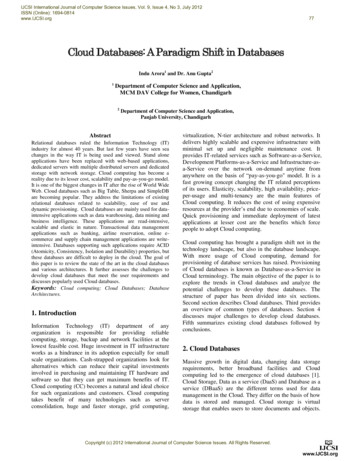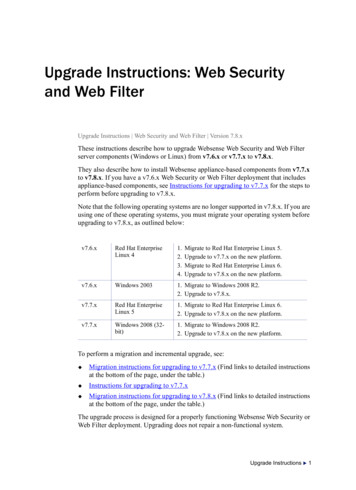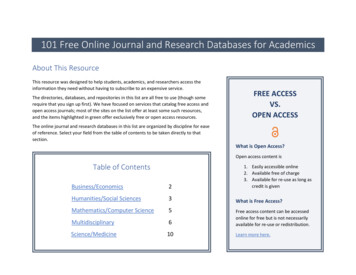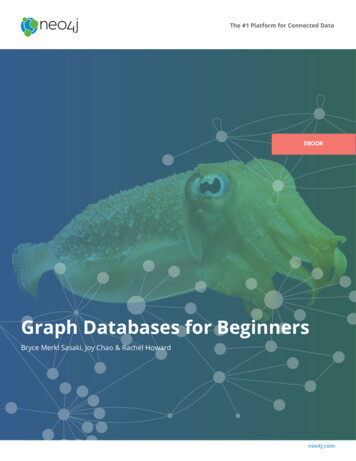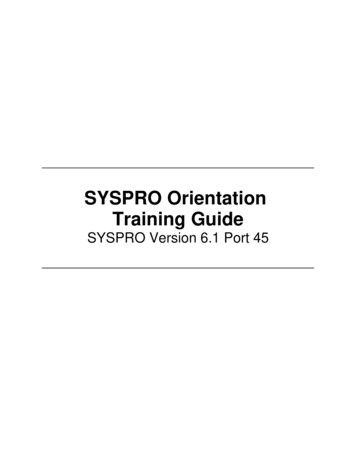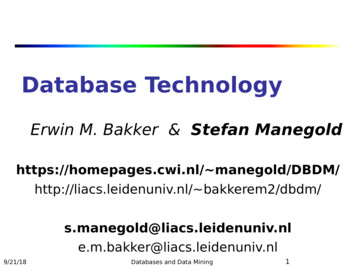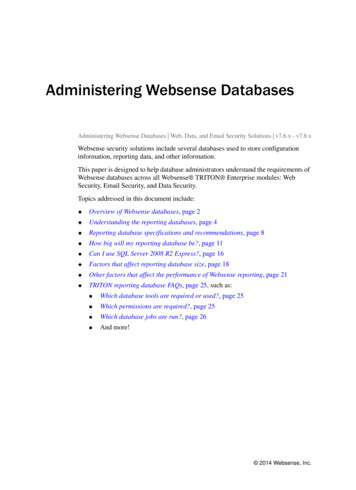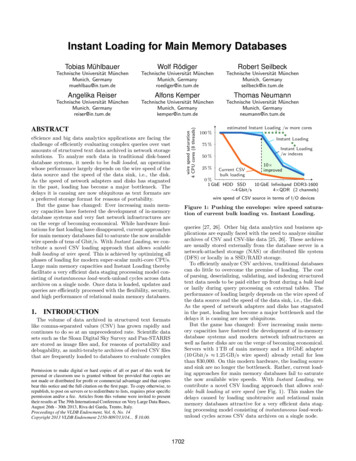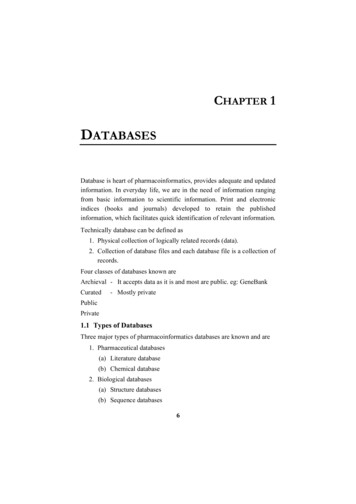
Transcription
CHAPTER 1DATABASESDatabase is heart of pharmacoinformatics, provides adequate and updatedinformation. In everyday life, we are in the need of information rangingfrom basic information to scientific information. Print and electronicindices (books and journals) developed to retain the publishedinformation, which facilitates quick identification of relevant information.Technically database can be defined as1. Physical collection of logically related records (data).2. Collection of database files and each database file is a collection ofrecords.Four classes of databases known areArchieval - It accepts data as it is and most are public. eg: GeneBankCurated- Mostly privatePublicPrivate1.1 Types of DatabasesThree major types of pharmacoinformatics databases are known and are1. Pharmaceutical databases(a) Literature database(b) Chemical database2. Biological databases(a) Structure databases(b) Sequence databases6
Databases73. Relational databases(a) Structured Query Language (SQL)(b) Practical Extraction and Report Language (PERL)1.2 Components of DatabasesDatabase has two main components1. Field: Each piece of information in a database is called field, whichmeans the smallest unit in a database. In database there can be fivecategories of fields, they are: Numeric Character Logic Memo Date2. Record: All the related events of particular field constitute a record,which is a collection of logically related fields.1.3 Database SchemaThe overall description of a database is called as database schema and 3types of schemas are known.1. Internal schema: It contains definitions of the stored records andspecifies how the data is stored.2. External schema: It describes external views of the data, there aremany external schema for the given database. It excludes irrelevantdata as well as data which the user is not authorized to access.3. Conceptual schema: It describes the types of data stored in databaseand relationships between them.1.3.1 Database Architecture The database architecture defines the nature of the data and structureof the data. The database architecture specifies, set of rules and processes thatdictate how data should be stored in a database and how data isaccessed by components of a system. The database architecture includes data types, relationships andnaming conventions. It describes the organization of all databaseobjects and their working methodologies. It affects integrity,reliability, scalability and performance of database.
8Elementary Pharmacoinformatics1.3.2 ANSI-SPARC 3 Level ArchitectureAmerican National Standard Institute - Standards Planning AndRequirements Committee (ANSI - SPARC) is an abstract design standardfor Database Management System (DBMS). Most commercial DBMS arebased on this system.1. It allows independent customized user views – each user should beable to access the same data.2. It hides the physical storage details from users.3. The database administrator should be able to change the databasestorage structure without affecting the user views.4. The internal structure of the database should be able to changes tothe physical aspects of the storage.The database administrator should be able to change the conceptual orglobal structure of the database without affecting the users.1.3.3 Data RedundancyIdentical data stored in two or more files are known as data redundancy.Dependencies between attribute (column) causes data redundancy. Itoccurs in database systems which have a field that is repeated in two ormore tables. It leads to data anomalies and corruption, hence should beavoided. Database normalization prevents redundancy by making use ofproper foreign keys.1.4 Database Applications Redundancy can be reducedData inconsistencies can be avoidedAllows data sharing and data migration between systemsProvides security restrictionData integrity can be maintainedBalances conflicting requirements.1.5 Database Management System (DBMS)The stress is given to creation as well as management of database.Database management involves creating, modifying, deleting and addingdata in files and using this data to generate reports or answer the queries.
Databases9The software allows to perform these functions easily are called asdatabase management system (DBMS). DBMS attempt to make thephysical data non-redundant and also optimizes resource utilization. Thewindows based database available in the market is MS ACCESS, whichis a part of Microsoft windows.Fig. 1.1 Schema represents DBMS approach.DBMS allows inserting, updating, deleting and processing of data.Some of the important DBMS are Oracle, Ingress, Sybase, Dbase 3 ,Foxpro, MS access, Dataease, Dataflex, Advanced revelation., etc.Primary tasks of DBMS are: Database development: Define and organize the contents,relationships and structure of the data needed to build s database. Database interrogation: It involves information retrieval and reportgeneration. End users can selectively display information, producereports and documents. Database maintenance: It helps in adding, deleting, updating,correcting and protecting the data in a database. Application development: It is used to develop prototypes of dataentry careens queries, forms, reports, tables and lebels for aprototype application / use 4th Generation Language (4GL) orapplication generator to develop program codes.Benefits of DBMS1.2.3.4.The amount of data redundancy in stored data can be reduced.Data inconsistencies can be removed.Stored data can be shared by a single or multiple users.Standards can be set and followed.
10Elementary Pharmacoinformatics5. Data integrity can be maintained.6. Security of data can be implemented.7. Data independence can be achieved.1.6 Relational Database Management SystemA relational database matches data by using common characteristicsfound within the data set. The resulting groups of data are organized andmuch easier for people to understand. Such a grouping uses the relationalmodel / schema and this database is called as relational database. The software used to do this grouping is called as relational database managementsystem (RDMS).1.7 NormalizationDatabase normalization is a critical part of good database architecture,which ensures data integrity and avoids data redundancy.1.8 RelationshipDatabase relationship creates a history for the tables.normalized database has a well-organized hierarchy.relationship between two tables, one table is the parent andthe child. For example, a patient table may be the parent ofdetail table.A properlyFor eachone table isprescription1.9 Primary and Foreign KeysDatabase relationships are embodied through primary keys in parenttables and foreign keys in child tables. Primary key is a field in a table whose value uniquely identifieseach record and defines relationship within a database. Foreign key is a field in a table that refers to parent records inanother table. It need not have unique values in the referencingrelation.1.10 Elements of DBMS Data Definition Language (DDL): It provides link betweenlogical and physical views of the database. It is used to define thephysical characteristics of each record and fields.
Databases 11Data Manipulation Language (DML): It provides techniques forretrieval, sorting, display and deletion of data/records.Data Query Language (DQL): It allows retrieving data from thedatabase and imposing ordering upon it.Data Control Language (DCL): It controls the access to data andto the database.1.11 Relational DatabasesA relational database uses relationally two-dimensional tables to storedifferent pieces of information inside tables and nothing more. Alloperations on data are done on the tables themselves or produce othertables as a result. A relational database contains one or many tables,which is a basic storage structure of relational database managementsystem (RDMS).1.11.1 Relational Database TerminologyRelational database theory uses set of mathematical terms, which areroughly equivalent to Structured Query Language (SQL) databaseterminology.Relational termRealtion, baseDerivedTupleAttributeSQL equivalenttableview, query result, result setRowcoloumnAttributeTupleRelation
12Elementary PharmacoinformaticsA table is set of rows and columns. Each row is set of column withonly one value for each. All rows from the same table have the same setof columns. The row from a relational table is analogous to a record, andthe columns to a field. Relational database serve in two ways.1. Retrieving subset of its column.2. Retrieving subset of its row.1.12 Rules Governing Relational DatabaseCODD rules and Normalization rules are the two important rules whichgoverns the functions of relational database.1.12.1 Codd RulesThey specify set of rules that relational database must comply in order tobe relational.Rule 1- The information ruleAll data should be presented to the user in table form. Data arerepresented only one way; as values within columns within rows1. The basic requirement of the relational database2. Simple, consistent and versatile.Rule 2- Guarranteed access ruleAll data should be accessible without ambiguity. This can beaccomplished through a combination of the table name, primary key andcolumn name.1. Every value can be accessed by providing table name, column nameand key.2. All data are uniquely identified and accessible via this identity.Rule 3- Systematic insert, update and deleteAll fields should be allowed to remain empty. This involves the supportof a null value, which is distinct from an empty string or a number with avalue of zero. This can’t apply to primary keys. In addition, mostdatabase implementations support the concept of a nun-null fieldconstraint that prevents null values in a specific table column.Rule 4- Dynamic on-line catalogueA relational database must provide access through the same tools that areused to access data. This is usually accomplished by storing the structure
Databases13definition within special system tables. Catalog can be queried byauthorized users as part of the database.Rule 5- Comprehensive data sublanguage ruleThe database must support at least one clearly defined language thatincludes functionality for data definition, data manipulation, dataintegrity and database transaction control. All commercial relationaldatabases use forms of the standard SQL as their supportedcomprehensive language.1. Used interactively and embedded within programs.2. Supports data definition, data manipulation, security, integrityconstraints and transaction processing.Rule 6- View updating ruleData can be presented to the user in different logical combinations, calledviews. Each view should support the same full range of data manipulationthat direct-access to a table has available. In practice, providing updateand delete access to logical views is difficult and is not fully supported byany current database.Rule 7- High-level insert, update and deleteData can be retrieved from a relational database in sets constructed ofdata from multiple rows and or multiple tables. This rule states insert,update and delete operations should be supported for any retrievable setrather than just for a single row in a single table.Rule 8- Physical data independenceThe user is isolated from the physical method of storing and retrievinginformation from the database. Change can be made to the underlyingarchitecture without affecting the user access.Rule 9- Logical data independenceData should not change when logical structure changes. Users andprograms are independent of the logical structure of the database.Rule 10- Integrity independenceSQL should support constraints on user input that maintain databaseintegrity. All databases do preserve two constraints through SQL.Rule 11-Distribution independenceA user should be completely unaware of whether or not the database isdistributed.
14Elementary PharmacoinformaticsRule 12-No subversion ruleThere should be no way to modify the database structure other thanthrough the multiple row database language.Codd’s ZERO ruleThe system be able to manage databases entirely through its relationalcapabilities, no matter what additional capabilities the system maysupport.1.12.2 NormalizationNormalization is the process of simplifying the relationship between dataelements in the records.TitleAuthorname 1Authorname 2ISBNSubjectPagesPublishersPHP Thomson0672317845MySQL300SamsThis table is not very efficient with storage. The names of the authors aretoo long, contains many characters. The repetition of their names willoccupy more storage space, and there is chance for entering their namewith spell mistake. This leads to less efficient searching and gives resultsmissing with some data. Normalization helps in this regard to reduce theredundant data, to improve storage efficiency, data integrity andscalability.Normalization is a step by step decomposition of complex recordsinto simple records and are carried out1. To structure the data between tables so that data maintenance issimplified.2. To allow data retrieval at optimal speed.3. To simplify data maintenance through updates, inserts and deletes.4. To reduce the need to restructure tables as new application byrationalization arise.5. To improve the quality of design for an application byrationalization of table data.
Databases15Normalization decomposes data into two dimensional tables,eliminates any relationship in which table data does fully depend uponthe primary key of a record and contains transitive dependencies. Thedatabase community developed series of guidelines called as normalforms. They are First normal form (1 NF) Second normal form (2 NF) Third normal form (3 NF) Fourth normal form (4 NF) Fifth normal form (5 NF) Domain / key normal form (DKNF) Sixth normal form (6 NF)First normal form (1 NF)The above table contains two (more than one) author field and containsmore than one piece of information. This complicates the searchoperation and First normal form helps in overcoming these problems bymodifying the table. 1NF involves the removal of redundant data fromhorizontal rows and ensures that there is no duplication of data in thetable. 1NF creates separate tables for each group of related data andidentify each row with a column or set of columns.Normalized by 1NFTitleAuthorISBNSubjectPagesPublishersPHP and MySQLWeb DevelopmentLukeWelling0672317842MySQL867SamsPHP and MySQLWeb DevelopmentLauraThomson0672317842PHP867SamsMySQL tutorialLauraThomson0672317845MySQL300SamsMySQL tutorialLukeWelling0672317845MySQL300SamsIn this case author and subject columns are reduced into one. Splitting thetable into author table, subject table and book table will improves thenormalization process.
16Elementary PharmacoinformaticsAuthor IDAuthor ID12First nameLukeLauraLast nameWellingThomsonAuthor table is splitted into two columns in order to store littleinformation in each coloumn. Each table has a primary key, whichconnects all the tables when querying the data. A primary key must beunique (no two books will be given same ISBN number).Subject tableSubject IDSubject1MySQL2PHPBook TableISBNTitlePagesPublisher0672317842PHP and MySQL Web Development867Sams0672317845MySQL Tutorial300SamsSecond normal form (2 NF)Second normal form deals with redundancy of data in vertical columns.In this table publisher column contains repeating data. Second normalform breaks this table and creates separate publisher information table.ISBNTitlePagesPublisher0672317842PHP and MySQL Web Development867Sams0672317845MySQL Tutorial300SamsNormalised TablePublisher IDPublisher1Sams1. 2NF meets all the requirements of the first normal form.2. It removes subsets of data that apply to multiple rows of a table andplaces them in separate tables.3. 2NF creates relationships between these new tables and theirpredecessors through the use of foreign keys.
Databases17Third normal form (3 NF)3NF looks for data which is not dependent on the primary key andremove those columns.1.13 Scripting LanguagesEvery computer architecture has its own ‘machine language’ such asFORTRAN, C, C . A disadvantage of compilers is, whenevermodification is made to source code, it must be recompiled before it canrun. The computer scripts offer an ‘alternative strategy’, scriptinglanguages, use interpreters instead of compilers. Python, Ruby and PERLare some of the popular scripting languages useful in pharmacoinformatics.Script – What you give an actor ?Program – What you give an audience ?PERL - Practical Extraction and Report LanguagePERL is a high level but easy to use programming language and availablefor most operating systems. It makes easy things easier and hard thingspossible where as professional programming languages make all thingsequally difficult. Using PERL series of complex tasks can be reduced to asingle statement. PERL is preferred for processing sequence analysis anddatabase management.Bio-PERLA popular tool-kit developed as a collection of integrated PERL modulesfor transforming and manipulating sequence data and annotations,accession remote databases and parsing output from programs such asBLAST, FASTA etc. Bio-PERL also facilitates local execution ofprograms from the EMBOSS suite. Bio-PERL modules save time andeffort.Applications of Bio-PERL Bioperl provides access to sequence data and transforming formatsof databases Bioperl assists in sequence similarity search Bioperl creates and manipulates sequence alignment Bioperl is useful in searching structures of genome Bioperl develops machine readable annotations
18Elementary PharmacoinformaticsSequence analysis: Parsing and annotation is useful in the analysis ofsimple patterns and Bioperl provides mechanisms for parsing andrunning.BLAST parsing: Parsing NCBI, WuBlast, bl2seq and psi-blast can bedone through the bioperls modules Bio::Tools::Blast Bio::Tools::Bplite Bio::Tools::BPbl2seq Bio::Tools::BPpsiliteBLAST running: Running BLAST locally and remotely is built-in tobioperl through the modules Bio::Tools::Run::StandAloneBLast Bio::Tools::Run::RemoteBlastMultiple sequence alignment parsing: Multiple sequence alignment arealso staple of bioinformatics research. Bioperl offers the Bio::AlignIOsystem for reading and writing MSA reports produced by a variety ofsources include ClustalW and CCG.ClustalW and TCoffee: Parsing ClustalW and CCG can be done throughthe bioperls modules Bio::Tools::Run::Alignment::Clustal Bio::Tools::Run:: Alignment::TCoffeeGene prediction and parsing: Genscan and Mzef produce Bio::SeqFeature::GeneStructure for gene prediction and parsing1.14 Structured Query Language (SQL)Structured Query Language (SQL) has been a command language,provides an interface to relational database systems. In common usage ofSQL also encompasses Data Manipulations Language (DML), forINSERTs, UPDATEs, DELETEs and Data Definition Language (DDL),used for creating and modifying tables and other database structures.A relational database uses, relationally or two-dimensional tables tostore different pieces of information inside tables and nothing more. Alloperations on data are done on the tables themselves or produce othertables as the result. A relational database contains one or many tables,which is a basic storage structure of relational database managementsystem (RDMS). Each row is set of column with only one value for each.
Databases19All rows from the same table have the same set of columns. The rowfrom a relational table is analogous to a record, and the columns to afield. Relational database serves in two ways¾ Retrieving subset of its column.¾ Retrieving subset of its row.S. NoMedicine nameCategoryCostExpiry dateProperties1. It can be accessed and modified by executing Structured QueryLanguage (SQL) statements.2. It contains a collection of tables with no physical pointers and uses aset of operators.3. A single row or table representing all data required for a particularmedicine, each row in a table should be identified by a primary key,which allows no duplicate key / values.4. A column or an attribute contains the medicine name.5. The serial number identifies a medicine in the table. In this example,the serial number column is designated as primary key.6. A primary key must contain value and the value must be unique.7. A column containing cost value is a foreign key which defines howtable relate to each other.8. A field may have no value in it, this is called a null value.9. A field can be found at the intersection of row and column, there canbe one value in it.General guideline for executing SQL commands SQL commands may be on one / many line. Clauses are usually placed on separate lines. Tabulation can be used. Command words can’t be split across lines. SQL commands are not case sensitive. Place a semi-colon (;) at the end of the last clause.
20Elementary PharmacoinformaticsSQL features SQL can be used by a range of users, including those with little or noprogram knowledge. It is non procedural language. It reduces the amount of time required for creating and maintainingsystemsSQL rules1. It starts with a verb, each verb is followed by number of clauses anda space ( ) separates clauses.2. A comma (,) separates parameters without a clause.3. A semicolon (;) is used to end SQL statements.4. Statement may be split across lines but keywords may not.5. Lexical units such as identifiers, operator names, literals areseparated by one or more spaces or other delimiters that will not beconfused with the lexical unit.6. Reserved words cannot be used as identifiers unless enclosed withdouble quotes.7. Identifier can contain up to 30 characters and must start with analphabetic character.8. Character and date literals must be enclosed within single quotes.9. Numeric literals can be represented by simple values.10. Scientific notation as 2 105.11. Comments may be enclosed between /*and*/ symbols and may bemulti line.12. Single line comments may be prefixed with a – symbol.Components of SQLData definition language (DDL): It is set of SQL commands used tocreate, modify and delete database structures but not data.Examples:Create: To create objects / tables in the database.Alter: Alter the structure of the database.Drop: Delete objects from the database.
Databases21Truncate: Remove all records from a table, including all spaces allocatedfor the records are removed.Data Manipulation Language (DML): It is area of SQL that changingdata within the database.Examples:Insert: Insert records (database) into a tableUpdate: Updates existing data within a table.Delete: Deletes specified records from a table, the space for the recordsremain.Call: Call a PL/SQL or Java program.Explain Plan: Explain access path to data.Lock: TABLE control concurrency.Data Control Language (DCL): It is the component of SQL statementthat control access to data and to the database.Examples:Commit: Save work doneSave Point: Identify a point in a transaction to which we can roll backRollback: Restore database to original since the last COMMITSet Transaction: Change transaction options like what rollback segmentto use.Grant /Revoke: Grant or take back permissions to or from the oracleusers.Data Query Language (DQL): It is the component of SQL statementthat allows retrieving data from the database and imposing ordering uponit.ExampleSelect: Retrieve data from the database.Using CREATE command
22Elementary PharmacoinformaticsUsing INSERT commandUsing “/” helps adding next set of data (record) without writing newinsert commandUsing SELECT commandUsing SELECT command
DatabasesUsing DISTINCT commandUsing AND commandUsing OR commandUsing DELETE commandUsing TRUNCATE command23
24Elementary PharmacoinformaticsTruncate command removes data only and retains the constructed table,so that data can be added further.Using SELECT commandUsing DROP commandDrop command completely removes the constructed table along withstored data.
windows based database available in the market is MS ACCESS, which is a part of Microsoft windows. Fig. 1.1 Schema represents DBMS approach. DBMS allows inserting, updating, deleting and processing of data. Some of the important DBMS are Oracle, Ingress, Sybase, Dbase 3 , Foxpro, MS access, Dataease, Dataflex, Advanced revelation., etc.
